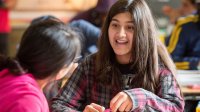A Discussion Protocol for Group Learning Experiences
High school teachers and students can use a theater-based strategy to cultivate curiosity and engagement in class.
Your content has been saved!
Go to My Saved Content.If you’re looking for a way to engage your students and transition them with ease into a learning community, the following three simple phrases can offer you and your students a wonderful tool to begin their day or class period:
“I observe...” (what can be seen)
“I perceive...” (reading behind what can be seen)
“I wonder...” (engaging in curiosity)
Adapted from one of Eric Morris’s acting craft approaches, Observe, Perceive, Wonder is a group learning experience that can be utilized in the classroom for a number of learning intentions as well as to reduce stress, focus attention, help students to connect with others, and create a positive learning environment. (It is similar to the See, Think, Wonder protocol from Harvard’s Project Zero.)
The exercise can be used at the beginning of class, perhaps after a simple relaxation technique like box breathing to allow students to let go of their distractions, self-regulate, and enter the present moment.
Demonstrating the Practice
I’ve found the best way to introduce this activity to students is to model it first. Invite another student to be your partner, and ask them to stand in front of you. While students are facing each other, the teacher starts first and says one thing that they observe about the student (“I observe that you have blue eyes”), then something they perceive about the student (“I perceive that you are thoughtful about the feelings of others”), and closes with something they wonder about the student (“I wonder what will be the focus of your next creative writing assignment”).
The student then repeats the activity about the teacher. It can be helpful to remind students that comments should be considerate of others and their feelings (no “I see your complexion is blotchy,” please).
In thinking about wonder, it’s really important that students feel safe to be curious, because curiosity moves us toward self-awareness. How you pair the class is up to your professional judgment. You can ask students to select a partner, turn to the person next to them, or select the pairs. I find it good to mix this up, as it allows for students to get to know more about one another, move outside of their own head, and become involved with another person. The mood in the class shifts to a calmer environment, which encourages students’ readiness to engage in learning.
Using This Practice in Academics
This strategy can also be applied in English and history classrooms. Students can use the questions to inhabit the lives of fictional and historical characters and explore a range of texts, which provides students with practice in presenting knowledge from written texts in a range of forms. For example, you can ask the students to imagine they were Jem in To Kill a Mockingbird meeting Dill for the first time. What did he observe, perceive, and wonder about his new friend?
Student A (as Jem, looking at Dill)
“I observe that you have a cowlick.”
“I perceive you to be fascinated with Boo Radley.”
“I wonder about your father.”
Student B (as Dill, looking at Jem)
“I observe you to be very strong.”
“I perceive that you are very responsible.”
“I wonder if you would run out on a dare.”
Students can share their observations verbally with a partner or as a written individual response. The ideas can also be discussed as a whole group activity to build knowledge and develop understanding. The questions are also a great starting point to evaluate historical sources such as speeches, journal entries, images, and video footage.
Benefits for English Language Learners
The strategy is also very useful for English language learners, who often work best in small group activities that are less teacher directed. Observe, Perceive, Wonder is the perfect choice because it takes the focus off the individual and directs it onto their partner. This reduces the pressure of speaking a new language in front of the whole class and may reduce self-consciousness when students practice speaking and listening.
The structure of the statements can serve as a scaffold and provide students with a sentence frame to add other descriptive language to their observations while working with different partners. Partners can learn more about one another, see the things they have in common, and discover and celebrate their differences. For an ELL classroom, this can be a very important approach to building a safe space and sense of community. Teachers can gain insight about their students and their thinking as the students engage in this exercise.
A Useful Method for Providing Feedback
Teachers can also share their thinking and provide feedback to students through this approach. It’s an ideal way to identify strengths in student work:
“I observe that you have read the text closely and are able to identify detailed information about the characters.”
“I perceive that you are able to interpret the actions of characters and how they connect to the possible themes of the play.”
“I wonder if you can extend your ideas further and outline them with use of wider vocabulary and descriptive language.”
Students can also provide peer feedback or reflect on their own assessment tasks. Add a rubric to guide their evaluation and help them observe where they have met criteria, perceive places that they could extend their response, and wonder about how they can approach tasks differently in the future.
